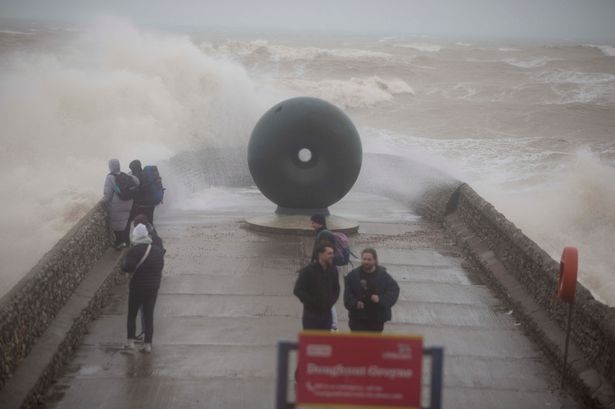Storm Éowyn, the fifth named storm of the meteorological year, is poised to unleash a formidable assault on parts of the UK and Ireland, prompting the Met Office to issue severe weather warnings for strong winds and high waves. The storm’s rapid intensification and trajectory are expected to create hazardous conditions, particularly along coastal areas, where large waves and wind-blown debris pose a significant “danger to life.” The combination of powerful winds and high tides will exacerbate the risk of coastal flooding and erosion, threatening both infrastructure and human safety. Inland areas are also anticipated to experience disruptive winds, with the potential for localized damage to property and transportation networks.
The Met Office’s warnings highlight the severity of the impending storm. A “danger to life” warning, the highest level of alert, underscores the immediate and significant threat posed by Éowyn. This warning encompasses the potential for exceptionally large waves, driven by the storm’s intense winds, to overtop sea defenses and inundate coastal communities. The force of these waves, combined with the impact of wind-borne debris, can pose a lethal threat to individuals in exposed areas. The seriousness of the situation demands that residents in affected regions take immediate precautions to safeguard their safety and property, including adhering to evacuation orders if issued by local authorities.
The meteorological dynamics driving Storm Éowyn involve a complex interplay of atmospheric factors contributing to its rapid intensification and projected trajectory. The storm is fueled by a deep area of low pressure moving rapidly across the North Atlantic, generating an intense pressure gradient that accelerates wind speeds. This rapid intensification, often referred to as “bombogenesis” or a “weather bomb,” occurs when the atmospheric pressure at the storm’s center drops significantly within a short period, typically 24 hours. The storm’s track will determine the regions most severely impacted, with coastal areas facing the brunt of the extreme winds and waves. The precise timing and intensity of the storm’s impact remain subject to ongoing meteorological analysis, with the Met Office continuously monitoring and updating its forecasts to provide the most accurate and timely information to the public.
The potential impacts of Storm Éowyn extend beyond coastal regions, with inland areas also bracing for disruptive winds and potential hazards. Strong gusts can damage power lines, leading to widespread power outages and disrupting essential services. Fallen trees and other wind-blown debris can obstruct roads and railways, causing travel delays and potential accidents. The high winds also pose a risk to high-sided vehicles and structures, emphasizing the need for caution and preparedness. Communities inland are advised to secure loose objects, trim overhanging branches, and avoid unnecessary travel during the height of the storm. Staying informed about the latest weather updates and heeding any warnings issued by local authorities is crucial for minimizing potential risks.
Preparedness and mitigation strategies are paramount in minimizing the impact of Storm Éowyn and ensuring public safety. Coastal communities are urged to review evacuation plans, secure properties, and move valuables to higher ground. Inland residents should prepare for potential power outages by stocking up on essential supplies, including food, water, and medications. Securing loose objects outdoors and reinforcing vulnerable structures can help prevent wind damage. Staying informed about the latest weather developments through reputable sources, such as the Met Office and local authorities, is essential for making informed decisions and taking appropriate actions. Heeding warnings and following safety guidelines provided by emergency services can significantly reduce the risk of injury or property damage.
The arrival of Storm Éowyn underscores the increasing frequency and intensity of extreme weather events, highlighting the importance of long-term adaptation and resilience strategies. Climate change is contributing to warmer ocean temperatures and altered atmospheric patterns, creating conditions conducive to the development of more powerful storms. Investing in robust coastal defenses, strengthening infrastructure, and implementing early warning systems are crucial for mitigating the impacts of future storms. Community-based preparedness programs and public awareness campaigns can empower individuals to take proactive steps to protect themselves and their families. Addressing climate change through global cooperation and sustainable practices is essential for reducing the risks associated with increasingly volatile weather patterns and protecting communities from the devastating effects of extreme weather events.














